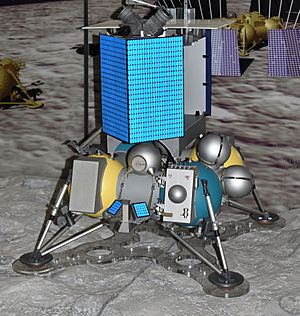Luna 25 facts for kids

Maquette of Luna 25 Moon lander
|
|
| Names | Luna-Glob lander |
|---|---|
| Mission type | Technology, Reconnaissance |
| Operator | SRI RAS (IKI RAN) |
| Mission duration | 1 year (planned) 2 years, 5 months (in progress) |
| Spacecraft properties | |
| Spacecraft type | Robotic lander |
| Manufacturer | NPO Lavochkin |
| Launch mass | 1,750 kg (3,860 lb) |
| Payload mass | 30 kg (66 lb) |
| Start of mission | |
| Launch date | 10 August 2023, 23:10 UTC |
| Rocket | Soyuz-2.1b / Fregat |
| Launch site | Vostochny Cosmodrome |
| Moon lander | |
| Landing date | 21 August 2023 |
| Landing site | Boguslavsky crater |
|
Luna-Glob programme
|
|
Luna 25 was a robotic lander mission from Russia. It was sent by Roscosmos, Russia's space agency, in August 2023. The mission's main goal was to land near the lunar south pole of the Moon, specifically near a crater called Boguslavsky.
The mission was first called "Luna-Glob lander." It was renamed Luna 25 to show it was part of the long-running Soviet Luna programme from the 1970s. This mission was the first lunar probe sent by Roscosmos to the Moon. It was also meant to be the first probe ever to land on the Moon's south pole.
Luna 25 launched on August 10, 2023, at 11:10 PM UTC. It rode into space on a Soyuz-2.1b rocket. The launch happened from the Vostochny Cosmodrome in Russia. Sadly, on August 19, 2023, the lander crashed on the Moon's surface. This happened during its attempt to get into a lower orbit before landing.
Contents
Exploring the Moon: Luna 25's Journey
The last time the Soviet Union sent a lander to the Moon was with Luna 24 in 1976. Plans for what became Luna 25 started in the late 1990s. Over the years, there were many attempts to get the project going. There were also ideas for working with other countries, like Japan's JAXA space agency and India's ISRO. However, these plans did not work out.
At first, the mission was going to have both a lander and an orbiter. The orbiter would have also dropped special tools onto the Moon. But in its final design, Luna 25 was only a lander. Its main job was to test new landing technology. The lander carried about 30 kilograms (66 pounds) of science tools. These included a robotic arm to collect soil samples. It might have even had tools for drilling into the Moon's surface.
The project faced several delays in the 2010s. One big reason was the failure of another mission called Phobos-Grunt in 2011. This led to a complete redesign of Luna 25. Also, the company building the spacecraft, NPO Lavochkin, was busy with other important projects. These included a weather satellite and a space observatory.
By 2017, the system that would power the spacecraft was being put together. The main place Luna 25 was supposed to land was south of the crater Boguslavsky. There were also two backup landing spots. The mission was planned to last for at least one Earth year once it landed on the Moon.
How Luna 25 Flew to the Moon
Luna 25 launched on August 10, 2023. It used a Soyuz-2 rocket with a Fregat upper stage. The launch site was the Vostochny Cosmodrome. On August 16, the probe successfully entered lunar orbit. It was scheduled to land on August 21.
Science Tools on Board
The Luna 25 lander carried about 30 kilograms (66 pounds) of scientific instruments. These tools were designed to study the Moon's surface and environment. Here are some of them:
- ADRON-LR: This tool would have looked for neutrons and gamma-rays in the Moon's soil.
- ARIES-L: This tool was for measuring plasma in the Moon's very thin atmosphere.
- LASMA-LR: A laser mass-spectrometer to study the Moon's surface materials.
- LIS-TV-RPM: This tool would have taken infrared pictures of minerals and other images.
- PmL: For measuring dust and tiny space rocks (micro-meteorites).
- THERMO-L: To measure how hot or cold the Moon's soil was.
- STS-L: For taking wide-angle and close-up pictures of the landing site.
- Laser retroreflector: This mirror-like device would have helped scientists measure the Moon's wobble and distance.
- BUNI: This system provided power and helped send science data.
A Swedish science tool called LINA-XSAN was originally supposed to fly on Luna 25. But because of delays, Sweden decided to send it on China's Chang'e 4 mission instead, which happened in 2019.
What Happened to Luna 25
On August 19, 2023, Roscosmos announced that something went wrong with the lander. This happened after they sent a command for the engine to fire briefly. This burn was supposed to move the lander into a special orbit before it landed.
Early information showed that the probe crashed into the Moon's surface. This happened because its engine fired for too long. Scientists tried to find and talk to the spacecraft on August 19 and 20, but they could not.
Based on early calculations, Luna 25 went into the wrong orbit before it crashed. A special team was put together to figure out exactly why the crash happened.
See also
 In Spanish: Luna 25 para niños
In Spanish: Luna 25 para niños

